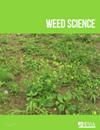Influence of Burial Depth and Soil Disturbance on the Emergence of Common Weed Species in the Iberian Peninsula
IF 2.1
2区 农林科学
Q2 AGRONOMY
引用次数: 1
Abstract
Abstract North African knapweed (Centaurea diluta Aiton), cornflower (Centaurea cyanus L.), corn marigold [Glebionis segetum (L.) Fourr.], rigid ryegrass (Lolium rigidum Gaudin), and corn poppy (Papaver rhoeas L.) are weeds of economic importance in the Iberian Peninsula, particularly due to limited herbicide options for effective control. For this reason, information about their seedling emergence has become critical to develop effective integrated management strategies and better time control actions. The aims of this study were to evaluate the effect of seed burial depth and soil disturbance on the emergence of these weed species. Two pot experiments were carried out to (1) quantify seedling emergence at three burial depths (2, 5, and 9 cm) and (2) characterize seedling emergence in response to different frequencies and timings of soil disturbance. Burial depth limited the emergence of G. segetum and P. rhoeas at 5 and 9 cm, respectively; while seedling emergence of C. diluta, C. cyanus, and L. rigidum were reduced by 92%, 90%, and 67% at 9 cm compared with 2 cm, respectively. Two or more sequential soil disturbance events increased total seedling emergence of C. diluta, P. rhoeas, and G. segetum compared with single events, while L. rigidum did not respond to repeated soil disturbance. These results suggest that turning the soil to bury weed seeds down to 5 cm or deeper would be a very effective method to control G. segetum and P. rhoeas and moderately effective to control C. cyanus. Also, the use of a stale seedbed would have some efficacy to reduce P. rhoeas and C. diluta weed pressure within the crop. This study illustrates how differences among species in seedling emergence in response to soil depth and disturbance can determine distinct emergence patterns ultimately influencing the selection of weed control tools and timing.埋藏深度和土壤扰动对伊比利亚半岛常见杂草产生的影响
摘要北非knapheed(Centaurea diluta Aiton)、矢车菊(Centaorea cyanus L.)、玉米万寿菊[Glebionis segetum(L.)Fourr.]、硬质黑麦草(Lolium rigidum Gaudin)和玉米罂粟(Papaver rheas L.)是伊比利亚半岛具有重要经济意义的杂草,特别是由于有效控制的除草剂选择有限。因此,有关其幼苗出现的信息对于制定有效的综合管理策略和更好的时间控制行动至关重要。本研究的目的是评估种子埋深和土壤扰动对这些杂草物种出现的影响。进行了两个盆栽实验,以(1)量化三个埋深(2、5和9厘米)的幼苗出苗,以及(2)表征不同频率和时间的土壤扰动对幼苗出苗的影响。埋葬深度限制了G.segetum和P.rhoeas的出现,分别为5厘米和9厘米;而在9厘米处,C.diluta、C.cyanus和L.rigidum的出苗率分别比2厘米处减少了92%、90%和67%。与单一事件相比,两个或多个连续的土壤扰动事件增加了C.diluta、P.rhoeas和G.segetum的总出苗率,而L.rigidum对重复的土壤扰动没有反应。这些结果表明,将土壤埋到5厘米或更深的杂草种子将是控制G.segetum和P.rhoeas的非常有效的方法,并且对控制C.cyanus是中等有效的方法。此外,使用不新鲜的苗床可以降低作物内的P.rheas和C.diluta杂草压力。这项研究说明了不同物种在幼苗出苗过程中对土壤深度和干扰的反应如何决定不同的出苗模式,最终影响杂草控制工具和时间的选择。
本文章由计算机程序翻译,如有差异,请以英文原文为准。
求助全文
约1分钟内获得全文
求助全文
来源期刊

Weed Science
农林科学-农艺学
CiteScore
4.60
自引率
12.00%
发文量
64
审稿时长
12-24 weeks
期刊介绍:
Weed Science publishes original research and scholarship in the form of peer-reviewed articles focused on fundamental research directly related to all aspects of weed science in agricultural systems. Topics for Weed Science include:
- the biology and ecology of weeds in agricultural, forestry, aquatic, turf, recreational, rights-of-way and other settings, genetics of weeds
- herbicide resistance, chemistry, biochemistry, physiology and molecular action of herbicides and plant growth regulators used to manage undesirable vegetation
- ecology of cropping and other agricultural systems as they relate to weed management
- biological and ecological aspects of weed control tools including biological agents, and herbicide resistant crops
- effect of weed management on soil, air and water.
 求助内容:
求助内容: 应助结果提醒方式:
应助结果提醒方式:


